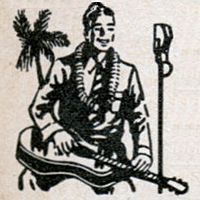The Awesome B11th Tuning
By David J. Stewart
The Hawaiian B11th Tuning
 Ah,
the wonderful sounds of Hawaii (by the way, the letter “w” in the Hawaiian
language is pronounced as the “v” sound. So it is pronounced “Havaii” and
Ewa Beach would be pronounced Eva beach. Don't be afraid to try other tunings at first,
but focus most of your efforts on the C6th. Having said that, I want to
share with you the B11th tuning, because too many players avoid it, which I
think is a BIG mistake!
Ah,
the wonderful sounds of Hawaii (by the way, the letter “w” in the Hawaiian
language is pronounced as the “v” sound. So it is pronounced “Havaii” and
Ewa Beach would be pronounced Eva beach. Don't be afraid to try other tunings at first,
but focus most of your efforts on the C6th. Having said that, I want to
share with you the B11th tuning, because too many players avoid it, which I
think is a BIG mistake!
You're missing out on SAND... SAND!!! (Barney Isaacs Jr. and Jules Ah See). It is interesting to note that both Jules Ah See and Isaac Jr. were born in 1924, but Jules passed away at just 36-years of age.
The best classic steel guitar song every made for lap steel. Wow! And it's very easy to play. Here's my version of SAND using a BOSS BR-600 to record. I'm using a $79 Artisan lap steel to record, pretty neat, huh?
For Hawaiian, the B11th is the most popular tuning next to C6th (bass to treble: C#, D#, F#, A ,C#, E). I love B11th!!! Here's me playing the song, HANA, on B11th, a track for you, and some tabs. Have fun!
Wear A Lei is a really nice song to learn. It was made for the B11th. Here's the tabs to learn it. Hear me play Wear A Lei. You can watch me play Wear A Lei and see how 'Green Screen' works for changing the background in a video.
Some songs just sound awesome on B11th, like SAND. Trying to playing SAND on C6th is like using using a saw to pound nails. Although you could play SAND on C6th, it just wouldn't sound proper. I believe the song SAND was written by a steel guitarist to be played on B11th. Today SAND is popular request in Hawaii, as is MAPUANA (another B11th favorite).
Did you know that the surface has only been scratched for new songs on the lap steel. I challenge everyone to work up some of your own unique nice arrangements on lap steel and claim them for your own. There are a million song names just waiting to be claimed. How about Island Sea Waves? Maybe, Rainbows Over Sandy Beach. Or perhaps, Moon Over Kona? Ever think of, Maui Palms? Song titles catch on quickly. Lord willing, I hope to write some of my own one day.
There's only 3 strings to retune to go from a C6th to a B11th. You just raise string 2 a half tone and then lower strings 4 and 5 a half tone each. That's it!
There are many different styles, tunings, techniques, guitar effects, and types of steel guitars. The hardest part is finding what's right for you. Personally, I like a wide variety of steel guitars and play several different styles. I enjoy the awesome sounds of a pedal steel, the big bassy strings on an 8-string non-pedal steel guitar, or the simplicity of a 6-string Frypan lap steel. Each has its own unique place. My greatest reward is seeing the happiness on people's faces when I play steel guitar. I love to open my music set with Moon of Manakoora in the D9th tuning (which is just dropping string 4 from G to F# on your C6th). And I also drop string 6 from C# to C. Here's some tabs for Moon of Manakoora.
How D'Ya Do is a famous B11th Hawaiian tune that is often requested. Here's some free tab and a rhythm track to learn the song. B11th is very close to the C6th in tuning, just a few half tones difference. Drop strings 4 and 5 a half tone and raise string 2 a half and you're all set (assuming that you already has the bottom strings tuned to C#). That's just three half tone changes to go from C6th+7th to B11th. I love the natural diminished chords found on the B11th on strings 2,3,4,5.
To get started you you need a
steel bar
(I use Dunlop brand), a
plastic
thumb pick, 2 metal
finger picks, a
lap steel,
an instrument cord and an amplifier. You can get everything at Amazon.com. The guitar in the picture below is a D-8 Rickenbacker, i.e., a
double neck, 8-strings per neck; but I recommend that you learn with
6-strings (which is where 95% of everything is played anyway). By far,
6-string lap steels are the most commonly manufactured, sold and played. You
can do wonders with just 6-strings. The 8-string (also 10, 12 and 14 string)
steel guitars simply allow for more chord possibilities and larger chord
voicings. However, those extra strings WILL get in the way and bother you if
you hardly ever use them if it's not your usual style. If you are serious
about learning the steel guitar, I recommend that you invest in both a 6 and
an 8 string lap steel. Check out this awesome intro from “South
Green Seas” using the B11th tuning. That wonderful low “BOOM” sound is a
B note on the 8th string. Here's the B11th variation used (from low to high:
B, F#, B, D#, F#, A, C#, E). Gotta love it! Strum the strings at the first
fret, and then open without the bar.
You've Got C6th On Your B11th!
One day I was surprised and amazed while playing the B11th tuning as I realized something. If you eliminate the first top string on your B11th, you've got a C6th on strings 2,3 and 4!!! Literally, everything that you can play on strings 1,2,3 on your C6th you can transfer over and play on strings 2,3,4 on your B11th tuning. If you add the top string on your B11th, it would be like adding a high G on the C6th tuning. So strings 1,2,3,4 on your B11th plays exactly like G-E-C-A (treble to bass) on your C6th. Try it. Try some of the musical pieces that you would normally play on strings one-through-three on the C6th and play it instead on strings two-through-four on the B11th.
I'm not saying to play the B11th as C6th. What I am saying is that understanding this connection between the two tunings will help you to play some single note work on the B11th, especially if you get lost in a song and you're only playing a single neck steel guitar. It also opens up many possibilities for learning some new licks and phrases on the B11th.
If you play pedal steel C6th or are familiar
with pedal steel, then you know that the B11th tuning is the same as
pressing down pedals 5 and 6 on the pedal steel guitar. Pedal 5 gives you
D9th tuning by lowering string 4 a half tone from G to Gb. I do this most
often with a forward bar slant while playing C6th. Pedal 6 lowers string 5 a
half tone from E to Eb, which combined with pedal 5 gives you the B11th
tuning. On the C6th tuning, if you raise the 2nd string a half tone from C to C#
gives you an A7th tuning which Jerry Byrd used to record the hit song,
Hilo March.
Learning Other Tunings and Advancing on the B11th Tuning
I've never tried to learn the musical scales on the B11th (i.e., the do, ra, me, fa, so, la, ti, do), but some players do. I just know a handful of songs and where the chords are at on B11th, and that works for me. In other words, I cannot play the B11th by ear (and don't want to). I play C6th by ear. I don't want to confuse myself by learning the scales for a bunch of different tunings. I can also play the E9th pedal steel by ear and know my scales well. But I've never tried that for F#m9th, Bbdim9th (Bill Leavitt tuning), B11th, C#m7th, et cetera on the lap steel.
I love playing E MAMA E in the E9th tuning, so I have memorized the song just to play in that one tuning (and it's definitely worth it). There's nothing like strumming the E9th all across the 6-strings and sliding up an octave. The tuning is easy to remember for me because I also play E9th pedal steel guitar and the open tuning is the same (treble to bass: E - B - G# - F# - E - D). An Eight string is pretty too, but 6-string is just fine. This is definitely a Hawaiian song.
I only want to learn all my scales on the C6th lap steel, and that's the lap steel tuning that I play by ear. I can jump in on any song with any band and play along on C6th lap steel or E9th pedal steel. I'm content with that. If I were to learn all my scales on B11th, then it would confuse me and I would hit the wrong notes when playing C6th. I don't want to do that. So I recommend learning the C6th lap steel inside and out, knowing all your scales. But for B11th, just memorize a few songs. The exception is if you're going to be playing B11th a lot as a Hawaiian player. Then it would be worth your while to learn the scales and dig deeper into the tuning. It all depends on how much you're going to be using a particular tuning.
It is extremely rare that you find a person that can
remember all the scales for umpteen tunings. That's why Jeff Newman used to
teach that you cannot go back-n-forth between playing a Universal 12-strings
pedal steel, verses playing a D-10 pedal steel. Some people could do it, but
I wouldn't. I never got into Universal, but have always wanted to. I didn't
simply because I didn't want to part with some of the E9th and C6th changes
that I became accustomed to over the years on my D-10. A Universal can do
more, and yet less at the same time. Still, Universal is awesome!
On a 6-String Lap Steel, Using a B Note On The 6th String Gives You a Perfect B11th Chord
If you think about it, using a B note on the bottom 6th string makes a lot of sense. You've already got a C# on the 2nd string. The tuning is called B11th, but hardly anyone uses the B note when playing 6-strings. Most players opt for a C#. Study the chord chart below and you'll see that a B11th chord is composed of the notes (low to high): B - D# - F# - A - C# - E. The B gives you your root note and a perfect B11th chord all the way across. The notes I just gave you is exactly how you tune the B11th tuning.
Music Chord Structures
| 1 | 3 | 5 | 6 | 7 | ||||
| Key of C: | C | D | E | F | G | A | B | C |
| Key of A: | A | B | C# | D | E | F# | G# | A |
| Key of Bb | Bb | C | D | Eb | F | G | A | Bb |
| Key of B: | B | C# | D# | E | F# | G# | A# | B |
| Key of C: | C | D | E | F | G | A | B | C |
| Key of C# | C# | D# | F | F# | G# | A# | C | C# |
| Key of D: | D | E | F# | G | A | B | C# | D |
| Key of Eb | Eb | F | G | Ab | Bb | C | D | Eb |
| Key of E: | E | F# | G# | A | B | C# | D# | E |
| Key of F: | F | G | A | Bb | C | D | E | F |
| Key of F#: | F# | G# | A# | B | C# | D# | F | F# |
| Key of G: | G | A | B | C | D | E | F# | G |
| Key of G# | G# | A# | C | C# | D# | F | G | G# |
Major Chords on B11th Tuning
Also, notice that you have an A Major chord on strings 3,2,1 open (no frets). So if you pick strings 3,2,1 on fret 3, you've got a C Major chord; and a D chord on the 5th fret. It helps to know these things when you're tabbing out songs on BB. I had to figure out "ECHOES OF THE SOUTH PACIFIC" from scratch. I'm not real good at my chords actually, and I have to figure them out as I go.
Since I knew that I had an A Major chord on strings 1,2,3 open fret, I was able to work from there as a reference. I know that an augmented chord is formed by sharping the 5th note when starting from a major chord.
- A minor chord is a flatted 3rd note from a
major chord.
- A dominant 7th is formed by flatting the
7th note of a major scale. So you play notes 1,3 and 5 of the scale and
then add the flatted 7th note too.
- A 9th chord is the same as the dominant
7th, except you add the 9th (or 2nd note). Since there's only 8 notes in
a scale, you continue counting.
- An 11th chord is formed by adding the 11th
(or 4th) note to the scale.
- A 13th is formed by adding the 13th (or
6th note) to all the rest.
- And a diminished chord is a flatted 3rd and 5th note from a major chord. It all relates to the Major chord, and that's a good way to view chords I think.
So on the B11th tuning, open fret, your 11th note would be the E note on string 1.



